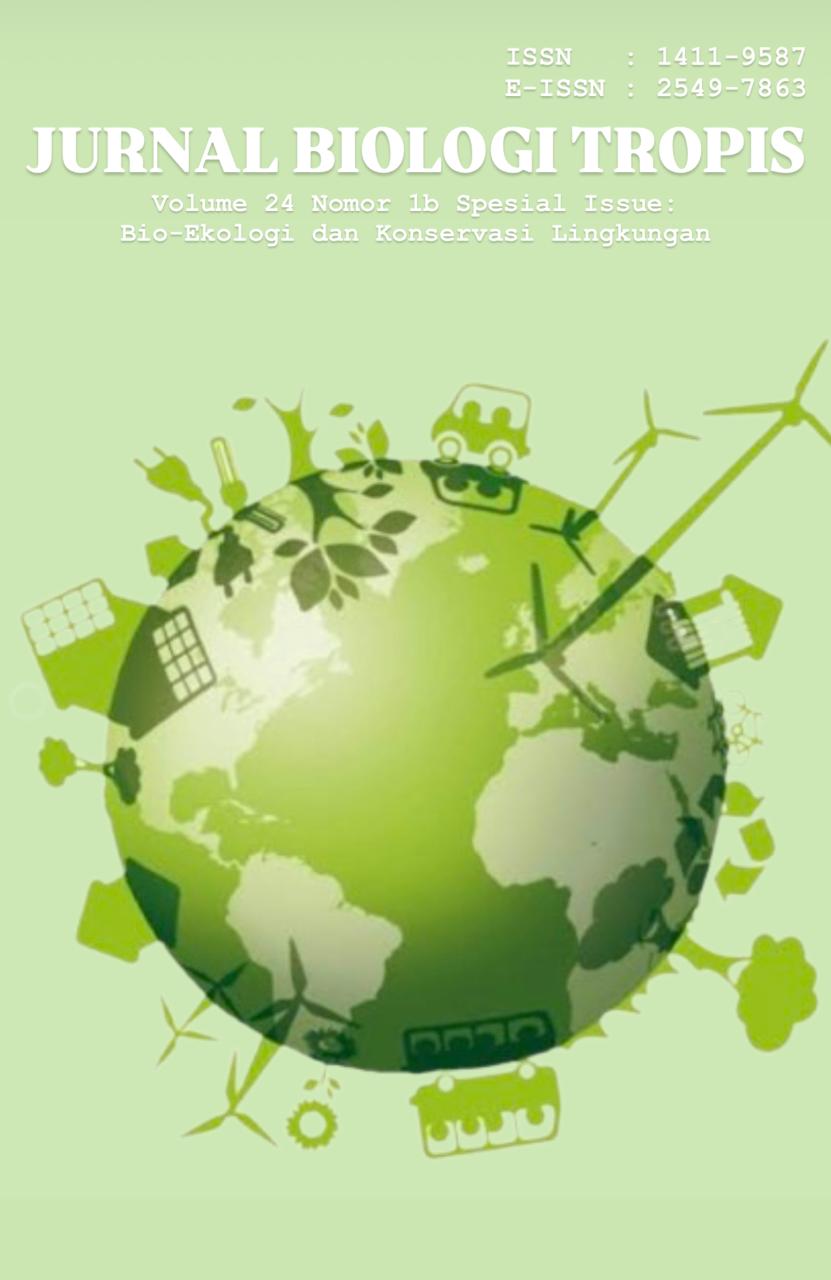Morphological Identification of Balinese Caulerpa Seaweeds
Authors
Ni Kadek Emi Sintha Dewi , I Gede Putu Wirawan , I Ketut SuadaDOI:
10.29303/jbt.v24i2b.7858Published:
2024-12-17Issue:
Vol. 24 No. 2b (2024): Special IssueKeywords:
Caulerpa, seaweeds, morphologyArticles
Downloads
How to Cite
Downloads
Metrics
Abstract
Bulung boni and bulung anggur are species of Caulerpa seaweeds commonly found along the coastline of Serangan Island, Bali. Although these species have been widely utilized in various ways, formal species identification of these two macroalgae in Bali had not been conducted prior to this study. This research aims to characterize the morphological structures of bulung boni and bulung anggur through detailed morphological examination. Identification keys and previous studies were used to assist in the morphological identification process. The findings revealed that bulung boni shares morphological characteristics with Caulerpa cylindracea, while bulung anggur is morphologically comparable to Caulerpa macrophysa. These results provide valuable insights into the species composition of seaweeds in the region and contribute to a better understanding of local biodiversity.
References
Altamirano, J. M., Andreakis, Souza-Egipsy, V., Zanolla, M., & De la Rosa, J. (2014). First record of Caulerpa cylindracea (Caulerpaceae, Chlorophyta) in Andalusia (Southern Spain). Anales del Jardín Botánico de Madrid. 71. e007. Doi: 10.3989/ajbm.231.
Belton, G. S., Reine, W. F. V., Huisman, J. M., Gurgel, S. G. A., & Draisma, C. F. D. (2014). Resolving phenotypic plasticity and species designation in the morphologically challenging Caulerpa racemosa-peltata complex (Chlorophyta, Caulerpaceae). Journal of Phycology, 50(1):32-54. Doi: https://doi.org/10.1111/jpy.12132.
Bentaallah, M.E.A., Taibi, N.E., & Cantasano, N. (2021). Additional new records of Caulerpa cylindracea Sonder 1845 along the West Algerian Coasts. Indian Journal of Geo Marine Sciences, 50(2): 122-129. Doi: 10.56042/ijms.v50i02.66088
Boumediene, H.K. & Lotfi, B. T. (2019). First record of invasive green algae Caulerpa racemosa var. cylindracea in Oran Bay (Western Algeria). Indian Journal of Geo Marine Sciences, 48 (03): 335-342. https://api.semanticscholar.org/CorpusID:165055770.
Cantasano, N., Pellicone, G., & Martino, V.D. (2017). The spread of Caulerpa cylindracea in Calabria (Italy) and the effects of shipping activities. Ocean & Coastal Management, 144: 51-58. Doi: https://doi.org/10.1016/j.ocecoaman.2017.04.014.
Cavas, L., Baskin, Y., Yurdakoc, K., & Olgun, N. (2006). Antiproliferative and newly- attributed apoptotic activities from a marina alga: Caulerpa racemosa var. cylindracea. Journal of Experimental Marine Biology and Ecology, 339: 111–119. doi: 10.1016/j.jembe.2006.07.019
Coppejans, E., P. Achana, L. Frederik, L. Khanjanapaj, & D.C. Olivier. (2010). Seaweeds of Mu Ko Tha Lae Tai (SE Thailand) : methodologies and field guide to the dominant species. Biodiversity Research and Training (BRT) Program. 278 p.
Darmawan, M., Zamani, N.P., Irianto, H.E., & Madduppa, H. (2021). Molecular Characterization of Caulerpa Racemosa (Caulerpales,Chlorophyta) from Indonesia Based on the Plastid TufA Gene. Squalen Bull. Mar. Fish. Postharvest Biotechnol., 16, 101–109. Doi: https://doi.org/10.15578/squalen.588.
Estrada, J.L., Bautista, N.S., & Dionisio-Sese, M.L. (2020). Morphological Variation of Two Common Sea Grapes (Caulerpa Lentillifera andCaulerpa Racemosa) from Selected Regions in the Philippines. Biodiversitas, 21, 1823–1832. Doi: https://doi.org/10.13057/biodiv/d210508.
Etcherla, M. & Rao, G. M. N. (2014). In vitro study of antimicrobial activity in marine algae Caulerpa taxifolia and Caulerpa racemosa (C. Agardh). International Journal of Applied Biology and Pharmaceutical Technology, 5(2): 57-62. https://search.bvsalud.org/gim/resource/es/sea-167821. (Dikutip pada 24 Februari 2022).
Fowler-Walker, M.J., Wernberg, T., & Connell, S.D. (2006). Differences in kelp morphology between wave sheltered and exposed localities: Morphologically plastic or fixed traits? Mar. Biol., 148: 755-767. Doi: https://doi.org/10.1007/s00227-005-0125-z.
Gaillande, C.D., Payri, C., Remoissenet, G., & Zubia, M. (2017). Caulerpa consumption, nutritional value and farming in the Indo-Pacific region. J. Appl. Phycol. 29: 2249-2266. Doi: https://doi.org/10.1007/s10811-016-0912-6.
García, C. F., Wysor, B., Rodríguez, R.R., Salamanca, E. P., & Verbrugen, H. (2016). DNA-assisted identification of Caulerpa (Caulerpaceae, Chlorophyta) reduces species richness estimates for Eastern Tropical Pacific. Phytotaxa, 252(3): 185-204. Doi: https://doi.org/10.11646/phytotaxa.252.3.2
Grant, W.M. (2015). "Molecular phylogeography and climate change biology of the invasive green marine macroalgae Caulerpa taxifolia and Caulerpa cylindracea in Australia" (thesis). Adelaide : The University of Adelaide. https://hdl.handle.net/2440/104681.
Kumar, J. G. S., Umamaherwari, S., Kavimani, S., & Ilavarasan, R. (2019). Pharmacological potential of green algae Caulerpa: A review. Int. J. of Pharmaceutical Science and Research, 10(3): 1014-1024. Doi: 10.13040/IJPSR.0975-8232.10(3).1014-24.
Littler, D.S. & Littler, M. M. (2009). Marine Plants of Pacific Panama. Smithsonian Tropical Research Institute. http://biogeodb.stri.si.edu/pacificalgae/list. (Dikutip pada 13 Juni 2022).
Matanjun P., Mohamed, S., Muhammad, K., & Mustapha, N. M. (2010). Comparison of cardiovascular protective effects of tropical seaweeds, Kappaphycus alvarezii, Caulerpa lentillifera, and Sargassum polycystum, on high-cholesterol/high-fat diet in rats. J Med Food.,13(4): 792-800. Doi: 10.1089/jmf.2008.1212
Misurcova, L. (2012). Chemical composition of seaweeds. In Handbook of marine macroalgae: Biotechnology and applied phycology. Edited by Se-Kwon Kim. John Wiley & Sons Ltd,. https://download.e-bookshelf.de/download/0000/5965/37/L-G-0000596537-0002363980.pdf. (dikutip pada 21 Februari 2022).
Pereira, L., & Neto, J. M. (2015). Marine Algae. Coimbra: CRC Press, Taylor & Francis Group. 379 p.
Pratama, O. (2020). Konservasi perairan sebagai upaya menjaga potensi kelautan dan perikanan. Direktorat Jenderal Pengelolaan Ruang Laut. https://kkp.go.id/djprl/. (Dikutip pada 24 Februari 2022).
Santamaría J., Tomas F., Ballesteros E. & Cebrian E. (2021). Herbivory on the Invasive Alga Caulerpa cylindracea: The Role of Omnivorous Fishes. Front. Mar. Sci. 8:702492. doi: 10.3389/fmars.2021.702492.
Sharma B.R. & Rhyu, D. Y. (2014). Anti-diabetic effects of Caulerpa lentillifera: stimulation of insulin secretion in pancreatic β-cells and enhancement of glucose uptake in adipocytes. Asian Pa.c J. Trop. Biomed., 4(7): 575-80. doi: 10.12980/APJTB.4.2014APJTB-2014-0091.
Sun, Y., Liu, Z., Song, S., Zhu, B., Zhao, L., Jiang, J., Liu, N., Wang, J., & Chen, X. (2019). Anti-inflammatory activity and structural identification of a sulfated polysaccharide CLGP4 from Caulerpa lentillifera. International Journal of Biological Macromolecules, 146(10). Doi: 10.1016/j.ijbiomac.2019.09.216
Toth, G.B., Harrysson, H., Wahlström, N., Olsson, J., Oerbekke, A., Steinhagen, S., Kinnby, A.; White, J., Albers, E., Edlund, U., et al. (2020). Effects of irradiance, temperature, nutrients, and pCO2 on the growth and biochemical composition of cultivated Ulva fenestrata. J. Appl. Phycol., 32: 3243–3254. Doi: https://doi.org/10.1007/s10811-020-02155-8.
Vettori, D., Nikora, V., & Biggs, H. (2020). Implications of hyposaline stress for seaweed morphology and biomechanics. Aquat. Bot., 162, 103188. Doi: https://doi.org/10.1016/j.aquabot.2019.103188.
License
Copyright (c) 2024 Ni Kadek Emi Sintha Dewi, I Gede Putu Wirawan, I Ketut Suada

This work is licensed under a Creative Commons Attribution 4.0 International License.

Jurnal Biologi Tropis is licensed under a Creative Commons Attribution 4.0 International License.
The copyright of the received article shall be assigned to the author as the owner of the paper. The intended copyright includes the right to publish the article in various forms (including reprints). The journal maintains the publishing rights to the published articles.
Authors are permitted to disseminate published articles by sharing the link/DOI of the article at the journal. Authors are allowed to use their articles for any legal purposes deemed necessary without written permission from the journal with an acknowledgment of initial publication to this journal.


























